Although Japanese food is known the world over and Japanese restaurants can be found in almost any major city these days, many people may not be aware of a few of the finer Japanese delicacies–such as the creepy creatures from the bottom of the sea–that you can eat.
When you think of the seabed, if you think of a place that is dark, murky, and full of scary creatures such as giant squid and sea monsters, then perfect! Because today we’re going to meet some of those guys’ roommates.
Join our not-so-intrepid island reporter who prefers to pass when it comes to dining on the low-life relegated to the muck on the seabed. She skips out on the taste tests and instead grabs an unsuspecting foreign visitor to try out some of Japan’s more esoteric treats.
Having lived on Shiraishi Island in the Seto Inland Sea for 17 years, I’ve had a chance to sample some strange aquatic creatures. I’ve eaten raw stuff, still crawling stuff, and recently deceased stuff. And I’ve had enough of all that!
In Japan, such foods that have an acquired taste are said to be otona-no-aji, which means “adult taste.” Surely this is because youth has to endure years of training and peer pressure to be convinced that such foods are delicious.
Sea urchin, for example. is a spiny, globular animal that surely no one in their right mind would ever think edible.
The first time anyone had a go at eating sea urchin must have looked a bit like a dog who has run into a porcupine.Luckily, however, it’s not the echinoderm itself that the Japanese eat. It’s the bright orange eggs inside the urchin that are sought after.
And did you know that some sea urchins can live as long as 200 years? Just food for thought the next time you’re wolfing down a bunch of baby sea urchins-to-be.
Mategai
I’ve never been so repulsed by an innocent sea creature as when I first saw mategai. They were in a bucket of salty water oozing in and out of both ends of their shells. The English translation is “Gould’s razor shell,” but I can tell you it’s a barely edible bivalve mollusc. Here on Shiraishi Island, the minshuku owners dig them up out of the sand in the littoral zone at the highest tide of each month.
▼Another one of those things that makes you think that the first person to discover they were edible must have been a lone human shipwrecked on a deserted island who had nothing else to eat.
Tsubugai a small snail-like creature is another local food eaten here on Shiraishi Island. They’re hunted by the locals at sunset along the seawalls.
▼Yuki, on Shiraishi Island, waves to me as she snorkels along a sea wall to collect tsubugai. She puts them into the red net bag she’s holding in her right hand.
▼This is what they look like when served at the restaurant.
▼A piece of metal shaped like a hook is used to evict the resident before ingesting it. Just one swallow does it!
But why let all this good food go to waste on someone like me who doesn’t appreciate the in-depth gastronomic pleasures of the bottom of the sea?
So I looked around for someone who might like to delve into it. Other than my Australian husband, who also has his limits, the only other foreigner on this small island of 566 people is my 20-year-old nephew Evan who is visiting for the summer. It’s his first time in Japan, so he would have no previous experience with these creatures. Furthermore, he has eaten chicken heads in China and he loves all kinds of food. As if that doesn’t qualify him right there, he further impressed me on a recent trip to Manabe Island when he voluntarily ate fish eyes after hearing the locals rave about them.
Octopus
Octopus is prosaic fare for the average Japanese so I thought it would be a good food for Evan to start with. I’m a bit partial to octopus after octopus hunting and learning how to turn octopus heads inside-out last week. But nonetheless, these creatures live at the bottom of the sea and are a mainstay of island fare, so he had to try them!
▼Octopus before…
▼Octopus after, on the plate.
Let’s find out how Evan likes octopus…
So far so good. The next “thing” I had prepared for him to try was namako (sea slug), a echinozoa, characterized by a globoid shape with no arms.
This time, we give Evan a bit of time to get to know his food first.
▼Namako before
▼Namako after: Sliced up raw, soaked in vinegar and served with shredded daikon radish.
Will Evan be able to stomach these?
Our last item is sazae, which is often translated as “turban shell.” It’s really just a huge snail.
▼Here it is out of its shell.
Do you think Evan can eat this? After the last episode, I’m really not so sure…
Notice that I’ve left sea urchin, mategai and tsubugai untested. I’d hate to spoil the fun for you, so the next time you’re near Japan’s sea side, be sure to try taste-testing them yourself. Good luck!
Images: Amy Chavez/RocketNews24 unless otherwise noted.

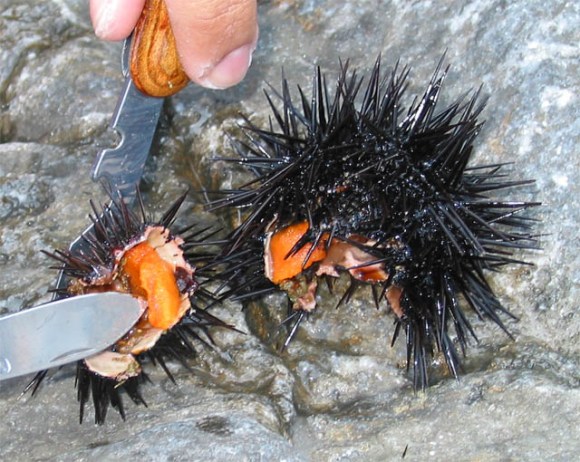
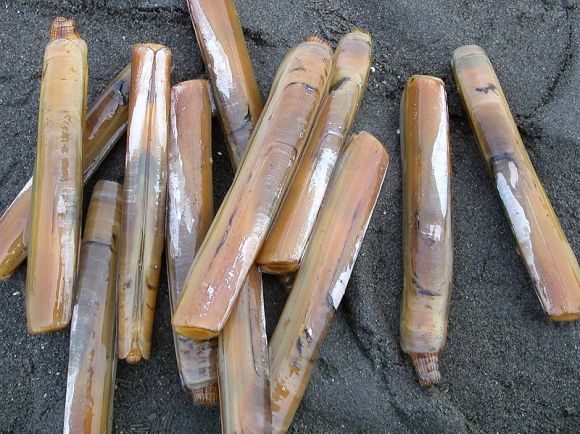
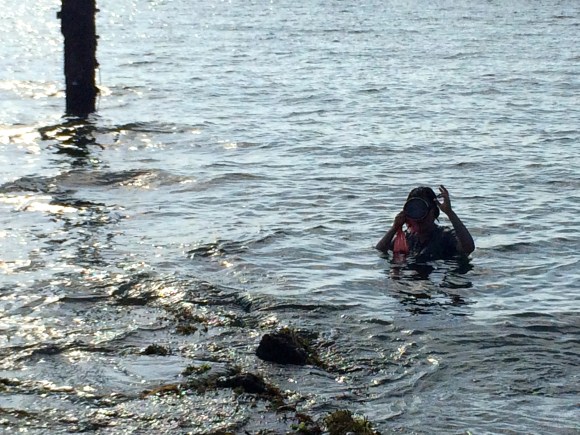

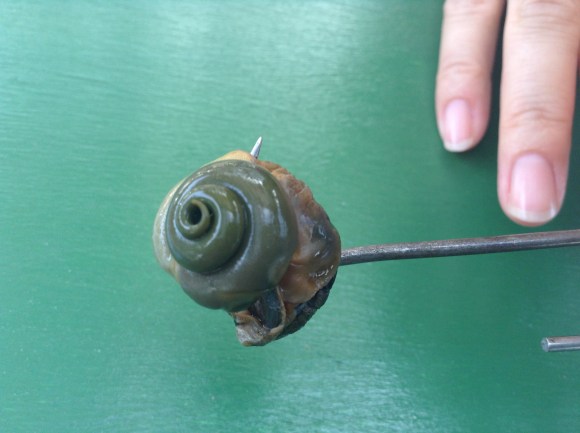
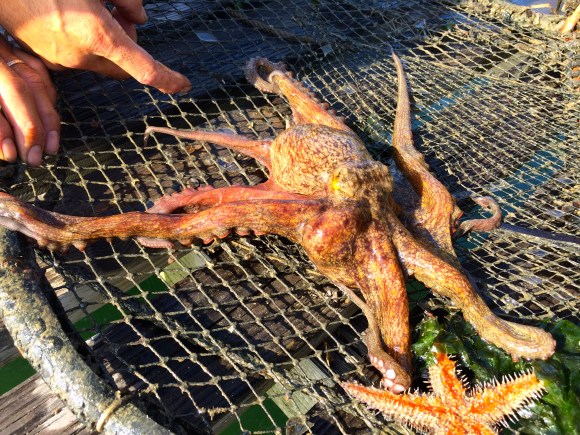
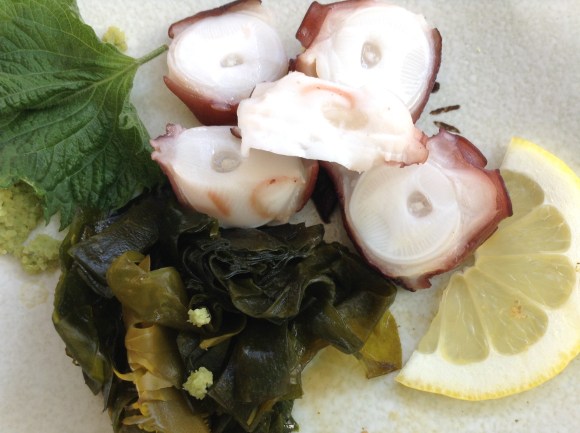
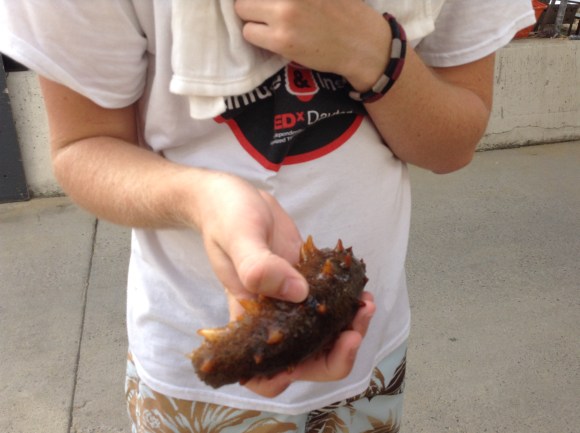
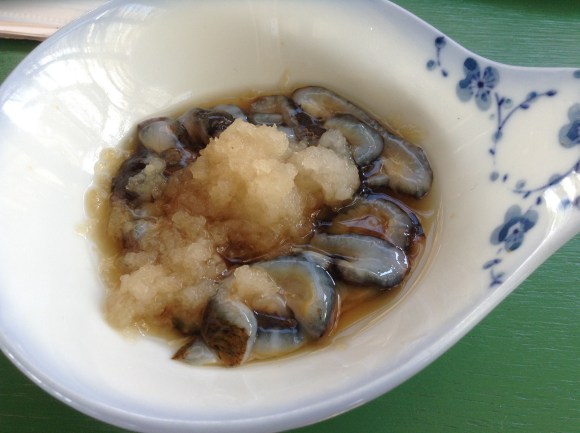
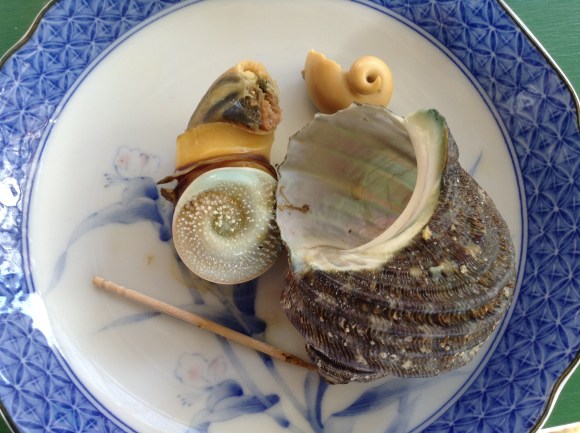
 Japanese netizens lament over the long, but sad life of sea urchins
Japanese netizens lament over the long, but sad life of sea urchins Shiraishi Island needs YOUR character ideas!
Shiraishi Island needs YOUR character ideas! Nissin comes out with new Cup Noodle using … “almost real sea urchin”!
Nissin comes out with new Cup Noodle using … “almost real sea urchin”! Japan’s secret garbage problem–and what you can do to help
Japan’s secret garbage problem–and what you can do to help Weird Japanese vending machine comes with a heartwarming twist
Weird Japanese vending machine comes with a heartwarming twist Japanese ramen restaurants under pressure from new yen banknotes
Japanese ramen restaurants under pressure from new yen banknotes Tokyo Tsukiji fish market site to be redeveloped with 50,000-seat stadium, hotel, shopping center
Tokyo Tsukiji fish market site to be redeveloped with 50,000-seat stadium, hotel, shopping center McDonald’s new Happy Meals offer up cute and practical Sanrio lifestyle goods
McDonald’s new Happy Meals offer up cute and practical Sanrio lifestyle goods Sakura tree falls on man at Sannenzaka near Kiyomizu temple in Kyoto 【Breaking News】
Sakura tree falls on man at Sannenzaka near Kiyomizu temple in Kyoto 【Breaking News】 French Fries Bread in Tokyo’s Shibuya becomes a hit on social media
French Fries Bread in Tokyo’s Shibuya becomes a hit on social media New private rooms on Tokaido Shinkansen change the way we travel from Tokyo to Kyoto
New private rooms on Tokaido Shinkansen change the way we travel from Tokyo to Kyoto We tried Korea’s way-too-big King Tonkatsu Burger at Lotteria 【Taste Test】
We tried Korea’s way-too-big King Tonkatsu Burger at Lotteria 【Taste Test】 Mt. Koya planning to instate visitor’s tax to cope with huge tourist numbers
Mt. Koya planning to instate visitor’s tax to cope with huge tourist numbers Beautiful Red and Blue Star luxury trains set to be Japan’s new Hokkaido travel stars
Beautiful Red and Blue Star luxury trains set to be Japan’s new Hokkaido travel stars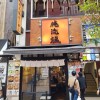 Non-ramen Ramen Restaurant Stars: The quest begins at Tokyo’s Oreryu Shio
Non-ramen Ramen Restaurant Stars: The quest begins at Tokyo’s Oreryu Shio All-you-can-drink Starbucks and amazing views part of Tokyo’s new 170 meter-high sky lounge
All-you-can-drink Starbucks and amazing views part of Tokyo’s new 170 meter-high sky lounge More foreign tourists than ever before in history visited Japan last month
More foreign tourists than ever before in history visited Japan last month Starbucks reopens at Shibuya Scramble Crossing with new look and design concept
Starbucks reopens at Shibuya Scramble Crossing with new look and design concept Studio Ghibli releases new action figures featuring Nausicaä of the Valley of the Wind characters
Studio Ghibli releases new action figures featuring Nausicaä of the Valley of the Wind characters Studio Ghibli glasses cases let anime characters keep an eye on your spectacles
Studio Ghibli glasses cases let anime characters keep an eye on your spectacles Is the new Shinkansen Train Desk ticket worth it?
Is the new Shinkansen Train Desk ticket worth it? Beautiful Ghibli sealing wax kits let you create accessories and elegant letter decorations【Pics】
Beautiful Ghibli sealing wax kits let you create accessories and elegant letter decorations【Pics】 Studio Ghibli releases Kiki’s Delivery Service chocolate cake pouches in Japan
Studio Ghibli releases Kiki’s Delivery Service chocolate cake pouches in Japan New definition of “Japanese whiskey” goes into effect to prevent fakes from fooling overseas buyers
New definition of “Japanese whiskey” goes into effect to prevent fakes from fooling overseas buyers Our Japanese reporter visits Costco in the U.S., finds super American and very Japanese things
Our Japanese reporter visits Costco in the U.S., finds super American and very Japanese things Studio Ghibli unveils Mother’s Day gift set that captures the love in My Neighbour Totoro
Studio Ghibli unveils Mother’s Day gift set that captures the love in My Neighbour Totoro Domino’s Japan now sells…pizza ears?
Domino’s Japan now sells…pizza ears? New Japanese KitKat flavour stars Sanrio characters, including Hello Kitty
New Japanese KitKat flavour stars Sanrio characters, including Hello Kitty New Pokémon cakes let you eat your way through Pikachu and all the Eevee evolutions
New Pokémon cakes let you eat your way through Pikachu and all the Eevee evolutions Sales of Japan’s most convenient train ticket/shopping payment cards suspended indefinitely
Sales of Japan’s most convenient train ticket/shopping payment cards suspended indefinitely Sold-out Studio Ghibli desktop humidifiers are back so Totoro can help you through the dry season
Sold-out Studio Ghibli desktop humidifiers are back so Totoro can help you through the dry season Japanese government to make first change to romanization spelling rules since the 1950s
Japanese government to make first change to romanization spelling rules since the 1950s Ghibli founders Toshio Suzuki and Hayao Miyazaki contribute to Japanese whisky Totoro label design
Ghibli founders Toshio Suzuki and Hayao Miyazaki contribute to Japanese whisky Totoro label design Doraemon found buried at sea as scene from 1993 anime becomes real life【Photos】
Doraemon found buried at sea as scene from 1993 anime becomes real life【Photos】 Tokyo’s most famous Starbucks is closed
Tokyo’s most famous Starbucks is closed One Piece characters’ nationalities revealed, but fans have mixed opinions
One Piece characters’ nationalities revealed, but fans have mixed opinions We asked a Uniqlo employee what four things we should buy and their suggestions didn’t disappoint
We asked a Uniqlo employee what four things we should buy and their suggestions didn’t disappoint Princesses, fruits, and blacksmiths: Study reveals the 30 most unusual family names in Japan
Princesses, fruits, and blacksmiths: Study reveals the 30 most unusual family names in Japan Creepy or cute? Come face to face with deep sea creatures as gachapon sushi toys!!
Creepy or cute? Come face to face with deep sea creatures as gachapon sushi toys!! Sea urchins will fight over the same piece of cabbage, Japan is adorably shocked to learn
Sea urchins will fight over the same piece of cabbage, Japan is adorably shocked to learn Vegetables are smarter than fruits: Three high IQ Japanese veggies
Vegetables are smarter than fruits: Three high IQ Japanese veggies Everything you need to know about takoyaki (octopus balls) 【Video】
Everything you need to know about takoyaki (octopus balls) 【Video】 Funny reaction video shows Americans trying sea urchin for the first time
Funny reaction video shows Americans trying sea urchin for the first time We try a rotating sushi chain’s super high-quality 3-layer caviar, sea urchin & fatty tuna sushi
We try a rotating sushi chain’s super high-quality 3-layer caviar, sea urchin & fatty tuna sushi Sea urchin ramen – Not for the faint of heart!
Sea urchin ramen – Not for the faint of heart! Better than mosquito repellent – The most eco-friendly (and spiritual) way to repel pests in Japan
Better than mosquito repellent – The most eco-friendly (and spiritual) way to repel pests in Japan The weird thing about Domino’s Japan’s Fish and Chips Pizza isn’t the fish or chips【Taste test】
The weird thing about Domino’s Japan’s Fish and Chips Pizza isn’t the fish or chips【Taste test】 We visit super popular tuna specialty joint Izakaya Hitoshi on Okinawa’s Ishigaki Island
We visit super popular tuna specialty joint Izakaya Hitoshi on Okinawa’s Ishigaki Island 2,500 yen for Tokyo ramen? High-end noodles in the high-rent Ginza district are totally worth it
2,500 yen for Tokyo ramen? High-end noodles in the high-rent Ginza district are totally worth it Japanese self-defense store CEO shows his dedication as he demos products on himself【Video】
Japanese self-defense store CEO shows his dedication as he demos products on himself【Video】 Stingray devours tank-mate squid at Japanese aquarium, shows what nature is really like 【Video】
Stingray devours tank-mate squid at Japanese aquarium, shows what nature is really like 【Video】 Chance to feel a shark’s nards and more at Sunshine Aquarium’s “Lots of Sex” Exhibit
Chance to feel a shark’s nards and more at Sunshine Aquarium’s “Lots of Sex” Exhibit We try “almost sea urchin” Cup Noodle, the latest chapter in instant ramen trickery【Taste test】
We try “almost sea urchin” Cup Noodle, the latest chapter in instant ramen trickery【Taste test】 Trying Family Mart’s Alternative Seafood Rice Bowl made with 5 imitation toppings【Taste test】
Trying Family Mart’s Alternative Seafood Rice Bowl made with 5 imitation toppings【Taste test】
Leave a Reply